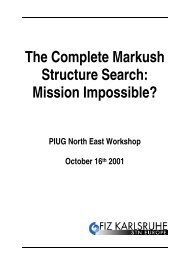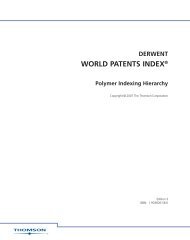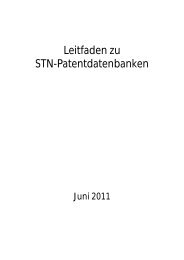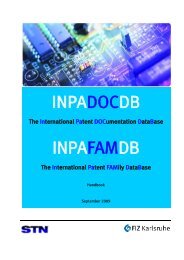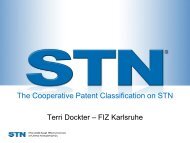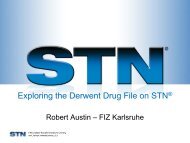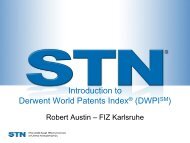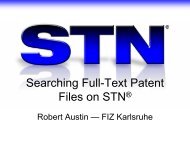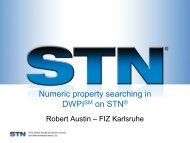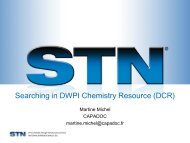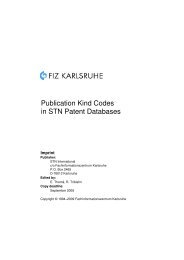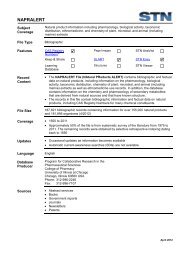DGENE Database Summary Sheet (DBSS) - STN International
DGENE Database Summary Sheet (DBSS) - STN International
DGENE Database Summary Sheet (DBSS) - STN International
Create successful ePaper yourself
Turn your PDF publications into a flip-book with our unique Google optimized e-Paper software.
<strong>DGENE</strong> (Derwent Geneseq)<br />
Subject<br />
Coverage<br />
File Type<br />
Features<br />
Record<br />
Content<br />
• All nucleotide sequences of 10 or more bases, all amino acid sequences of 4 or more<br />
residues, and probes and primers of any length.<br />
Bibliographic, sequence<br />
For direct code match or similarity (homology) sequence searching, FIZ Karlsruhe<br />
provides three specialized RUN package options, GETSEQ, GETSIM and BLAST ®<br />
Alerts (SDIs) Every two weeks<br />
CAS Registry Page Images <strong>STN</strong> ® AnaVist <br />
Number ® Identifiers<br />
Keep & Share SLART <strong>STN</strong> Easy ® <br />
Learning <strong>Database</strong> Structures <strong>STN</strong> ® Viewer <br />
• Information on nucleic acid and protein sequences extracted from the original (basic)<br />
patent documents published by 41 patent offices worldwide.<br />
• About 19 million sequence records within the database stem from nearly 150,000<br />
patents from around the globe.<br />
• Records contain a Thomson Reuters (Professional) UK Ltd. enhanced title from<br />
WPINDEX, a concise sequence description, an English abstract written especially for<br />
<strong>DGENE</strong> by one of Thomson Reuters (Professional) UK Ltd. experts, patent<br />
information, detailed indexing, a feature table, and sequence data.<br />
• For file crossover to WPINDEX, the DWPI accession number is available in all<br />
records.<br />
• DWPI family information can be directly displayed within <strong>DGENE</strong> using the FAM<br />
format.<br />
• Legal status data from INPADOCDB for corresponding <strong>DGENE</strong> patent sequence<br />
documents are available.<br />
File Size • More than 35.3 million records (05/2013)<br />
• More than 27.1 million nucleic acid sequences (05/2013)<br />
• More than 8.1 million protein sequences (05/2013)<br />
Coverage<br />
Updates<br />
Language<br />
<strong>Database</strong><br />
Producer<br />
1981-present<br />
Every two weeks<br />
English<br />
Thomson Reuters (Professional) UK Ltd.<br />
The Johnson Building<br />
77 Hatton Garden<br />
London EC1N 8JS<br />
United Kingdom<br />
Phone: +44 20 7433 4000<br />
Fax: +44 20 7433 4001<br />
Helpdesk: +44 20 7433 4999<br />
Email: ts.support.emea@thomsonreuters.com<br />
Copyright Holder: Thomson Reuters<br />
May 2013
2<br />
<strong>DGENE</strong><br />
Sources<br />
User Aids<br />
Clusters<br />
• Patents from the 41 patent issuing authorities covered by the Derwent World Patents<br />
Index ® (file WPIDS/WPIX/WPINDEX)<br />
• Online Helps (HELP DIRECTORY lists all help messages available)<br />
• Online Help as PDF: http://www.stn-international.de/dgene_help.html<br />
• <strong>STN</strong>GUIDE<br />
• <strong>DGENE</strong> Workshop Manual: http://www.stn-international.de/dgene_wm.html<br />
• Frequently Asked Questions about GETSIM/BLAST:<br />
http://www.stn-international.de/dgenefaq.html<br />
• ALLBIB<br />
• AUTHORS<br />
• BIOSCIENCE<br />
• CORPSOURCE<br />
• HPATENTS<br />
• MEDICINE<br />
• PATENTS<br />
• PHARMACOLOGY<br />
<strong>STN</strong> <strong>Database</strong> Clusters information (PDF)<br />
Pricing Enter HELP COST at an arrow prompt (=>).<br />
May 2013
Search and Display Field Codes<br />
Fields that allow left truncation are indicated by an asterisk (*).<br />
General Search Fields<br />
3<br />
<strong>DGENE</strong><br />
Search<br />
Display<br />
Search Field Name Code Search Examples Codes<br />
Basic Index* (contains single<br />
words from the title (TI),<br />
keyword (KW), abstract (AB),<br />
description (DESC), and<br />
organism name (ORGN) fields)<br />
None<br />
or<br />
/BI<br />
S F PROMOTER<br />
S HUMAN INSULIN (L) PREPARATION<br />
S JUNIPERUS VIRGINIANA<br />
TI, KW,<br />
AB,DESC,<br />
ORGN<br />
Accession Number /AN S 95P-R67826/AN AN<br />
Amino Acid (3) /AA S 5 S/AA AND 2 T/AA AA<br />
Amino Acid Count (1) /AA.CNT S L2 AND AA.CNT>9 AA<br />
Application Country<br />
/AC S AU/AC AI<br />
(WIPO code and text)<br />
Application Date (1) /AD S 6 JUN 1994/AD AI<br />
Application Number (2) /AP S AU1994-64520/AP<br />
AI<br />
S 1994AU-0064520/AP<br />
Application Number Group (2) /APPS S 1994AU-0064520/APPS AI, PRAI<br />
Application Year (1) /AY S 1990/AY AI<br />
Cross Reference (to related<br />
/CR S 90N-Q01810/CR<br />
CR<br />
<strong>DGENE</strong> sequence records) (or /XR)<br />
Data Entry Date (1) /DED S 19901220/DED DED<br />
Description /DESC S DYNORPHIN?/DESC DESC<br />
Document Type<br />
/DT S PATENT/DT<br />
DT<br />
(code and text)<br />
(or /TC)<br />
Entry Date (1)<br />
/ED S ED10 NA<br />
Organism Name /ORGN S ADENOVIRUS/ORGN ORGN<br />
Other Source (DWPI accession /OS S 94-151326/OS<br />
OS<br />
number)<br />
S 2000-012128/OS<br />
Patent Assignee (3)<br />
/PA S ZAMBON SPA/PA<br />
PA<br />
(or /CS)<br />
Patent Assignee Code (4) /PACO S BADI/PACO PA<br />
Patent Countries<br />
/PCS S UNITED KINGDOM/PCS PI<br />
(WIPO code and text)<br />
Patent Country<br />
/PC S DE/PC<br />
PI<br />
(WIPO code and text)<br />
S UNITED KINGDOM/PC<br />
Patent Kind Code /PK S FRA/PK PI<br />
Patent Number (2) /PN S DE4244565/PN<br />
PI<br />
S EP-348819/PN<br />
Patent Number Group (2) /PATS S EP-348819/PATS PI<br />
Patent Sequence Location /PSL S DISCLOSURE/PSL<br />
PSL<br />
S COL/PSL<br />
S FIG/PSL<br />
Priority Country<br />
/PRC S US/PRC AND L3<br />
PRAI<br />
(WIPO code and text)<br />
S UNITED STATES/PRC AND L3<br />
Priority Date (1) /PRD S 19930907/PRD PRAI<br />
May 2013
4<br />
<strong>DGENE</strong><br />
General Search Fields (cont'd)<br />
Search<br />
Display<br />
Search Field Name Code Search Examples Codes<br />
Priority Date First (1) /PRDF S 17 JUNE 1993/PRDF PRAI<br />
Priority Number (2) /PRN S 1993US-0078471/PRN<br />
PRAI<br />
S US1993-78471/PRN<br />
Priority Year (1) /PRY S 1993/PRY PRAI<br />
Priority Year, First (1) /PRYF S 1993/PRYF PRAI<br />
Publication Date (1) /PD S 18 JAN 1995/PD PI<br />
Publication Year (1) /PY S 1999/PY PI<br />
Sequence Length (1) /SQL S 70-90/SQL SQL<br />
Title* /TI S HUMAN INSULIN/TI TI<br />
(1) Numeric search field that may be searched using numeric operators or ranges.<br />
(2) Either <strong>STN</strong> format or Derwent format may be used.<br />
(3) Search with implied (S) proximity is available in this field.<br />
(4) The list of Thomson Reuters (Professional) UK Ltd.-assigned company codes for patent assignees matched with company names is<br />
available in this field. See page 14.<br />
SEQUENCE SIMILARITY SEARCHING (BLAST/GETSIM)<br />
The GETSIM and BLAST ® run packages are available to search the <strong>DGENE</strong> database for protein and<br />
nucleotide sequence data by similarity (homology). BLAST is provided in <strong>DGENE</strong> with the permission of the<br />
National Center for Biotechnology Information (NCBI) of the National Library of Medicine (NLM). GETSIM is<br />
provided in <strong>DGENE</strong> by FIZ Karlsruhe GmbH, and is based upon the FASTA algorithm.<br />
To initiate a BLAST or GETSIM search the following search codes have to be specified: SQP for searching<br />
peptide sequences (default), SQN for nucleotide sequences, or TSQN for searching peptide sequences<br />
translated from <strong>DGENE</strong> nucleotide sequences. The GETSIM or BLAST search can be run in offline BATCH<br />
mode or used as the basis of a current-awareness ALERT. The offline search mode offers an email<br />
notification option which allows users to see when batch search results are available for download. When<br />
using the SQN option it is possible to specify whether single (SIN), complementary (COM), or BOTH strands<br />
should be searched. The options can be specified together with the search code, e.g., /SQN COM. If no<br />
search option is given, SIN (single) will be used by default for GETSIM, and BOTH (both) will be used by<br />
BLAST. Note that for the TSQN option generally both strands will be searched, i.e., for a single polypeptide<br />
query, the TSQN option will cover all six possible translations (three reading frames of both the single and the<br />
complementary nucleotide sequences). Nucleotide and protein sequences can be subjected to a similarity<br />
search in various ways. A query can be prepared with the query command and saved beforehand, it can be<br />
entered directly on the command line using RUN GETSIM/BLAST, or it may be uploaded from an ASCII file<br />
using the UPLOAD command. You may also use the Sequence Query Upload Wizard from <strong>STN</strong> Express<br />
version 8.3+. A diagram is generated that shows the similarity between the retrieved sequences and the<br />
query. The x-axis represents the number of answers with a specific degree of similarity (represented by y-<br />
axis). In addition, two values are given, the query self score value defining the maximum score value possible<br />
when the query is aligned to itself, and the score value of the best answer of the retrieved answer set. You<br />
have three possibilities to select the result answer set.<br />
You can either:<br />
1) Keep the complete answer set (ALL)<br />
2) Keep a subset of the complete answer set by specifying a smaller number of just the top scoring answers.<br />
3) Specify the minimum percentage of the self score value, to keep a subset of the complete answer set,<br />
where the answers have a better score than your chosen minimum percentage of the query self score value.<br />
May 2013
5<br />
<strong>DGENE</strong><br />
The generated L-number contains all answers or the specified subset of answers, but they are sorted by<br />
descending accession number. This L-number may be re-arranged by descending similarity score or<br />
descending percent identity. Just type "SOR SCORE D" to sort by descending similarity score or SOR IDENT<br />
D" to sort by descending percent identity and the corresponding L-number at an arrow prompt.<br />
It is possible to see the alignment between the retrieved sequence and the query sequence with the display<br />
format ALIGN (for GETSIM or for BLAST). The top line is the query sequence and the bottom line the hit<br />
sequence. The BLAST ALIGN format follows the standard convention for NCBI alignment displays. The<br />
GETSIM ALIGN format uses two dots to represent identical nucleotides/peptides, a blank if there is no match,<br />
and one dot to indicate a chemical "family" match. Gaps inserted in the query or answer sequence for<br />
alignment purposes are shown with an underscore.<br />
GETSIM / BLAST: TYPES OF SEARCHES<br />
Description Search Code Search Example (4)<br />
Peptide Homology /SQP RUN BLAST L1 /SQP<br />
Nucleotide Homology<br />
Single Strand<br />
Complementary Strand<br />
Both Strands<br />
/SQN<br />
RUN BLAST L1 /SQN<br />
RUN GETSIM L1 /SQN SIN (1)<br />
RUN GETSIM L1 /SQN COM<br />
RUN BLAST L1 /SQN BOTH (2)<br />
Translated Peptide Homology /TSQN RUN BLAST L1 /TSQN<br />
Offline BATCH search<br />
Current-awareness ALERT (3)<br />
/SQP BATCH<br />
/SQN BATCH<br />
/TSQN BATCH<br />
/SQP ALERT<br />
/SQN ALERT<br />
/TSQN ALERT<br />
RUN GETSIM L1 /TSQN<br />
RUN BLAST L1 /SQP BATCH<br />
RUN GETSIM L1 /SQN BOTH BATCH<br />
RUN BLAST L1 /TSQN BATCH<br />
RUN BLAST L1 /SQP ALERT<br />
RUN GETSIM L1 /SQN BOTH ALERT<br />
RUN BLAST L1/TSQN ALERT<br />
(1) GETSIM default setting<br />
(2) BLAST default setting<br />
(3) Homology ALERT search, which runs every update of the database (once every two weeks).<br />
(4) Where L1 is a sequence query generated using the UPLOAD or QUERY command<br />
ADVANCED USER OPTIONS FOR BLAST<br />
For the experienced user of BLAST ® , a variety of options is available via the <strong>STN</strong> command line. Altering<br />
these parameters will have a profound effect on the outcome of the search. FIZ Karlsruhe strongly<br />
recommends that users are completely familiar with NCBI documentation before embarking on customizing<br />
any of these settings. For further information:<br />
http://blast.ncbi.nlm.nih.gov/Blast.cgi?CMD=Web&PAGE_TYPE=BlastDocs<br />
The advanced user options are specified with a single letter code preceded by a hyphen and followed by a<br />
blank and the required value, e.g. RUN BLAST L1 /SQN -E 0.1.<br />
May 2013
6<br />
<strong>DGENE</strong><br />
Advanced User Options<br />
Option Switch Values<br />
1. Filter -f T (True), F (False), C (coiled-coil). Default value is T.<br />
If T is set, for peptides the SEG, and for nucleotides the<br />
DUST filter is employed. C represents the 'coiled-coil' filter.<br />
2. Expectation Value -e Floating point number. (Default is 10)<br />
3. Word Size -w 11 (default) or 7-23 for nucleotides<br />
3 (default) or 2 for peptides<br />
4. Strand -s 1 (sin), 2 (com) or 3 (both)<br />
default value is 3<br />
5. Matrix -m BLOSUM62 (default), BLOSUM80,<br />
BLOSUM45, PAM30 or PAM70<br />
6. Gap Penalty -g 11 (peptides) (default)<br />
5 (nucleotides) (default)<br />
7. Gap Extension -x 1 (peptides) (default)<br />
2 (nucleotides) (default)<br />
8. Penalty for nucleotide mismatch -q -3 (default)<br />
9. Reward for nucleotide match -r 1 (default)<br />
BLAST Matrix settings (for option 5.)<br />
Please note that for a certain matrix only a restricted set of possible gap and gap extension values is possible.<br />
The settings available to each matrix are summarised in the table below. Default settings are indicated in the<br />
table. Any different combinations will be rejected by the system and a warning message issued.<br />
Matrix Gap Gap Extension<br />
BLOSUM62 9<br />
8<br />
7<br />
12<br />
11<br />
10<br />
BLOSUM80 8<br />
7<br />
6<br />
11<br />
10<br />
9<br />
BLOSUM45 13<br />
11<br />
12<br />
9<br />
15<br />
14<br />
13<br />
12<br />
19<br />
18<br />
17<br />
16<br />
2<br />
2<br />
2<br />
1<br />
1 (default)<br />
1<br />
2<br />
2<br />
2<br />
1<br />
1 (default)<br />
1<br />
3<br />
3<br />
3<br />
3<br />
2 (default)<br />
2<br />
2<br />
2<br />
1<br />
1<br />
1<br />
1<br />
May 2013
BLAST Matrix settings (for option 5.) (cont'd)<br />
7<br />
<strong>DGENE</strong><br />
Matrix Gap Gap Extension<br />
PAM30 7<br />
6<br />
5<br />
10<br />
8<br />
9<br />
PAM70 8<br />
7<br />
6<br />
11<br />
10<br />
9<br />
2<br />
2<br />
2<br />
1<br />
1<br />
1 (default)<br />
2<br />
2<br />
2<br />
1<br />
1 (default)<br />
1<br />
Example: Online GETSIM homology search for a protein<br />
=> run getsim<br />
LDHILQKTERGVRLHPLARTAKVKNEVNSFKAALSSLAKHGEYAPFARLLNLSGVNNLEHGLFPQLSAIA/sqp<br />
RUN GETSIM AT 17:03:06 ON 14 MAY 2008<br />
COPYRIGHT (C) 2008 FIZ KARLSRUHE GMBH<br />
120000 SEQUENCES PROCESSED<br />
........<br />
3190000 SEQUENCES PROCESSED<br />
1415 ANSWERS FOUND ABOVE A THRESHOLD OF 57<br />
QUERY SELF SCORE VALUE IS 443<br />
BEST ANSWER SCORE VALUE IS 443<br />
Similarity<br />
Score<br />
443 |<br />
|<br />
|<br />
|<br />
|<br />
|<br />
|<br />
|<br />
|<br />
|<br />
222 |<br />
||<br />
||<br />
||<br />
||<br />
||<br />
||<br />
|||||||||||||||||||||||||||||||||||||||||||||||||<br />
|||||||||||||||||||||||||||||||||||||||||||||||||<br />
|||||||||||||||||||||||||||||||||||||||||||||||||<br />
Answer Count 290 580 870 1160 1450<br />
May 2013
8<br />
<strong>DGENE</strong><br />
ENTER EITHER THE NUMBER OF ANSWERS YOU WISH TO KEEP<br />
OR ENTER MINIMUM PERCENT OF SELF SCORE FOLLOWED BY %<br />
(BEST ANSWER PERCENTAGE IS 100%)<br />
ENTER (ALL) OR ? :80%<br />
L1<br />
L1<br />
RUN STATEMENT CREATED<br />
23 LDHILQKTERGVRLHPLARTAKVKNEVNSFKAALSSLAKHGEYAPFARLL<br />
NLSGVNNLEHGLFPQLSAIA/SQP<br />
Answer set arranged by accession number; to sort by descending<br />
similarity score, enter at an arrow prompt (=>) "sor score d".<br />
=> sor score d<br />
PROCESSING COMPLETED FOR L1<br />
L2<br />
23 SOR L1 SCORE D<br />
=> d score align seq 1 10 23<br />
L2 ANSWER 1 OF 23 <strong>DGENE</strong> COPYRIGHT 2008 THOMSON REUTERS on <strong>STN</strong><br />
SCORE 443 100% of query self score 443<br />
ALIGN Smith-Waterman score: 443<br />
70 aa overlap starting at 253<br />
ldhilqktergvrlhplartakvknevnsfkaalsslakhgeyapfarllnlsgvnnleh<br />
::::::::::::::::::::::::::::::::::::::::::::::::::::::::::::<br />
ldhilqktergvrlhplartakvknevnsfkaalsslakhgeyapfarllnlsgvnnleh<br />
glfpqlsaia<br />
::::::::::<br />
glfpqlsaia<br />
SEQ<br />
1 rsmdsrpqki wmapsltesd mdyhkiltag lsvqqgivrq rvipvyqvnn<br />
51 leeicqliiq afeagvdfqe sadsfllmlc lhhayqgdyk lflesgavky<br />
101 leghgfrfev kkrdgvkrle ellpavssgk nikrtlaamp eeetteanag<br />
151 qflsfaslfl pklvvgekac lekvqrqiqv haeqgliqyp tawqsvghmm<br />
201 vifrlmrtnf likfllihqg mhmvaghdan davisnsvaq arfsgllivk<br />
251 tvldhilqkt ergvrlhpla rtakvknevn sfkaalssla khgeyapfar<br />
301 llnlsgvnnl ehglfpqlsa ialgvatahg stlagvnvge qyqqlreaat<br />
351 eaekqlqqya esreldhlgl ddqekkilmn fhqkkneisf qqtnamvtlr<br />
401 kerlakltea itaaslpkts ghydddddip fpgpindddn pghqdddptd<br />
451 sqdttipdvv vdpddgsyge yqsysengmn apddlvlfdl deddedtkpv<br />
.......<br />
L2 ANSWER 10 OF 23 <strong>DGENE</strong> COPYRIGHT 2008 THOMSON REUTERS on <strong>STN</strong><br />
SCORE 439 99% of query self score 443<br />
ALIGN Smith-Waterman score: 439<br />
70 aa overlap starting at 251<br />
ldhilqktergvrlhplartakvknevnsfkaalsslakhgeyapfarllnlsgvnnleh<br />
::::::::.:::::::::::::::::::::::::::::::::::::::::::::::::::<br />
ldhilqktdrgvrlhplartakvknevnsfkaalsslakhgeyapfarllnlsgvnnleh<br />
glfpqlsaia<br />
::::::::::<br />
glfpqlsaia<br />
SEQ<br />
1 mdsrpqkiwm xpsltesdmd yhkiltagls vqqgivrqkv ipvyqvnnle<br />
51 eicqliiqaf eagidfqesa dsfllmlclh hayqgdyklf lesgavkyle<br />
101 ghgfrfevkk rdgvkrleel lpavssgkni krtlaalpee etteanagqf<br />
151 lsfaslflpk lvvgekacle kvqrqiqvha eqgliqypta wqsvghmmvi<br />
201 frlmrtnfli kfllihqgmh mvaghdanda visnsvaqar fsgllivktv<br />
251 ldhilqktdr gvrlhplart akvknevnsf kaalsslakh geyapfarll<br />
301 nlsgvnnleh glfpqlsaia lgvatahgst lagvnvgeqy qqlreaatea<br />
351 ekqlqqyaes reldhlgldd qekkilmnfh qkkn<br />
May 2013
9<br />
<strong>DGENE</strong><br />
L2 ANSWER 23 OF 23 <strong>DGENE</strong> COPYRIGHT 2008 THOMSON REUTERS on <strong>STN</strong><br />
SCORE 367 82% of query self score 443<br />
ALIGN Smith-Waterman score: 367<br />
70 aa overlap starting at 233<br />
ldhilqktergvrlhplartakvknevnsfkaalsslakhgeyapfarllnlsgvnnleh<br />
:. :::::. :: ::::.::.:::::: ::: :::.::.:::::::::.:::::.:::::<br />
lefilqktdsgvtlhplvrtskvknevasfkqalsnlarhgeyapfarvlnlsginnleh<br />
glfpqlsaia<br />
::.:::::::<br />
glypqlsaia<br />
SEQ<br />
1 mdlhsllelg tkptaphvrn kkvilfdtnh qvsicnqiid ainsgidlgd<br />
51 llegglltlc vehyynsdkd kfntspvaky lrdagyefdv iknadatrfl<br />
101 dvspnephys plilalktle stesqrgrig lflsfcslfl pklvvgdras<br />
151 iekalrqvtv hqeqgivtyp nhwlttghmk vifgilrssf ilkfvlihqg<br />
201 vnlvtghday dsiisnsvgq trfsgllivk tvlefilqkt dsgvtlhplv<br />
251 rtskvkneva sfkqalsnla rhgeyapfar vlnlsginnl ehglypqlsa<br />
301 ialgvatahg stlagvnvge qyqqlreaah daevklqrrh ehqeiqaiae<br />
......<br />
May 2013
10<br />
<strong>DGENE</strong><br />
Example: Online BLAST homology search for a nucleotide with altered parameter<br />
=> run blast L1/sqn -e 0.1<br />
BLAST Version 2.2<br />
The BLAST software is used herein with permission of the<br />
National Center for Biotechnology Information (NCBI) of<br />
the National Library of Medicine (NLM)..........<br />
......<br />
Number of sequences better than 1.0e-01: 68<br />
......<br />
68 ANSWERS FOUND BELOW EXPECTATION VALUE OF 1.0e-01<br />
QUERY SELF SCORE VALUE IS 3503<br />
BEST ANSWER SCORE VALUE IS 3503<br />
Similarity<br />
Score<br />
3503 |<br />
|<br />
||<br />
||<br />
||<br />
||||||<br />
|||||||<br />
|||||||<br />
||||||||<br />
||||||||<br />
1752 ||||||||<br />
||||||||||<br />
||||||||||<br />
||||||||||<br />
|||||||||||<br />
||||||||||||<br />
||||||||||||||<br />
|||||||||||||||||<br />
||||||||||||||||||||||<br />
||||||||||||||||||||||||||||||<br />
Answer Count 20 40 60 80 100<br />
ENTER EITHER THE NUMBER OF ANSWERS YOU WISH TO KEEP<br />
OR ENTER MINIMUM PERCENT OF SELF SCORE FOLLOWED BY %<br />
(BEST ANSWER PERCENTAGE IS 100%)<br />
ENTER (ALL) OR ? :80%<br />
L2<br />
L2<br />
RUN STATEMENT CREATED<br />
4 ATGGCCCTGAAGAATGATGAGATAATAGATGCCACTCAAAAAGGAAATTG<br />
CTCTCGTTTCATGAATCACAGCTGTGAACCAAATTGTGAAACCCAAAAAT<br />
GGACTGTGAACGGACAACTGAGGGTTGGGTTTTTTACCACCAAACTGGTT<br />
.......<br />
GCAAGCTGACTCACGGTGTTATGAATAAGGAGCTGAAGTACTGTAAGAAT<br />
CCTGAGGACCTGGAGTGCAATGAGAATGTGAAACACAAAACCAAGGAGTA<br />
CATTAAGAAGTACATGCAGAAGTTTGGGGCTGTTTACAAACCCAAAGAGG<br />
ACACTGAATTAGAGTGA/SQN.-E 0.1<br />
Answer set arranged by accession number; to sort by descending<br />
similarity score, enter at an arrow prompt (=>) "sor score d".<br />
May 2013
=> sor score d<br />
PROCESSING COMPLETED FOR L5<br />
L3<br />
4 SOR L5 SCORE D<br />
11<br />
<strong>DGENE</strong><br />
=> d 1 4 score align<br />
L3 ANSWER 1 OF 4 <strong>DGENE</strong> COPYRIGHT 2008 THOMSON REUTERS on <strong>STN</strong><br />
SCORE 3503 100% of query self score 3503<br />
BLASTALIGN<br />
Query = 1767 letters<br />
Length = 2510<br />
Score = 3503 bits (1767), Expect = 0.0<br />
Identities = 1767/1767 (100%)<br />
Strand = Plus / Plus<br />
Query: 1<br />
Sbjct: 85<br />
atggccctgaagaatgatgagataatagatgccactcaaaaaggaaattgctctcgtttc<br />
||||||||||||||||||||||||||||||||||||||||||||||||||||||||||||<br />
atggccctgaagaatgatgagataatagatgccactcaaaaaggaaattgctctcgtttc<br />
Query: 61 atgaatcacagctgtgaaccaaattgtgaaacccaaaaatggactgtgaacggacaactg<br />
||||||||||||||||||||||||||||||||||||||||||||||||||||||||||||<br />
Sbjct: 145 atgaatcacagctgtgaaccaaattgtgaaacccaaaaatggactgtgaacggacaactg<br />
.<br />
.<br />
.<br />
Query: 1681 aaacacaaaaccaaggagtacattaagaagtacatgcagaagtttggggctgtttacaaa<br />
||||||||||||||||||||||||||||||||||||||||||||||||||||||||||||<br />
Sbjct: 1765 aaacacaaaaccaaggagtacattaagaagtacatgcagaagtttggggctgtttacaaa<br />
Query: 1741 cccaaagaggacactgaattagagtga 1767<br />
|||||||||||||||||||||||||||<br />
Sbjct: 1825 cccaaagaggacactgaattagagtga 1851<br />
L3 ANSWER 4 OF 4 <strong>DGENE</strong> COPYRIGHT 2008 THOMSON REUTERS on <strong>STN</strong><br />
SCORE 3140 89% of query self score 3503<br />
BLASTALIGN<br />
Query = 1767 letters<br />
Length = 6652<br />
Score = 3140 bits (1584), Expect = 0.0<br />
Identities = 1590/1592 (99%)<br />
Strand = Plus / Plus<br />
Query: 1 atggccctgaagaatgatgagataatagatgccactcaaaaaggaaattgctctcgtttc<br />
||||||||||||||||||||||||||||||||||||||||||||||||||||||||||||<br />
Sbjct: 3381 atggccctgaagaatgatgagataatagatgccactcaaaaaggaaattgctctcgtttc<br />
Query: 61 atgaatcacagctgtgaaccaaattgtgaaacccaaaaatggactgtgaacggacaactg<br />
||||||||||||||||||||||||||||||||||||||||||||||||||||||||||||<br />
Sbjct: 3441 atgaatcacagctgtgaaccaaattgtgaaacccaaaaatggactgtgaacggacaactg<br />
.<br />
.<br />
.<br />
Query: 1501 aaagtacgaattaaagaccgcaataaactttctacagaggaacgccggaagttgtttgag<br />
||||||||||||||||||||||||||||||||||||||||||||||||||||||||||||<br />
Sbjct: 4881 aaagtacgaattaaagaccgcaataaactttctacagaggaacgccggaagttgtttgag<br />
Query: 1561 caagaggtggctcaacgggaggctcagaaaca 1592<br />
||||||||||||||||||||||||||||||||<br />
Sbjct: 4941 caagaggtggctcaacgggaggctcagaaaca 4972<br />
May 2013
12<br />
<strong>DGENE</strong><br />
SEARCHING SEQUENCE DATA WITH THE GETSEQ RUN PACKAGE<br />
Sequence information (amino acid and nucleic acid sequences) may be retrieved by using a variety of search<br />
fields available with the GETSEQ run package. The query may be first created with the QUERY command,<br />
and subsequently searched through the GETSEQ run package specifying the query L-number (e.g., RUN<br />
GETSEQ L9, if L9 represents the sequence query). The L-number may also derive from a previous sequence<br />
search in another <strong>STN</strong> database with biosequence search capabilities, e.g., the CAS REGISTRY SM file. The<br />
query may also be directly entered within the GETSEQ package at a colon prompt after GETSEQ has been<br />
initialized with the RUN command (i.e., RUN GETSEQ). Offline sequence searching is also available for<br />
GETSEQ searches.<br />
SEQUENCE SEARCH TERMS<br />
Terms<br />
One-letter codes for common amino acids (1,2)<br />
Three-letter codes for common amino acids (1,2)<br />
Enclose codes or strings of codes in single<br />
quotes. Use dashes to separate codes in strings.<br />
One-letter codes for nucleic acids (3)<br />
Query Examples<br />
QUE LAGLL/SQSP<br />
QUE 'THR-SER-GLY-MET-THR'/SQSFP<br />
QUE 'GLP'GY/SQSP<br />
QUE 'LEU-ARG-ASP-THR'/SQEP<br />
QUE ATGAAN/SQEN<br />
QUE ATGAAN/SQSN<br />
(1) Enter 'HELP AAC' at an arrow prompt to display a table of the one- and three-letter codes for common amino acids.<br />
(2) Uncommon amino acids are represented in the sequence either by a related parent amino acid, if available, or by an 'X' (or 'XXX').<br />
Details about uncommon amino acids in a sequence can be found in the corresponding feature table (FEAT).<br />
(3) Enter 'HELP NUC' at an arrow prompt to display a table of the codes for nucleic acids.<br />
TYPES OF SEQUENCE SEARCHES<br />
Sequence data for nucleic acid and protein sequences are displayed in the SEQ field with one-letter codes<br />
and the SEQ3 field with three-letter codes for proteins only.<br />
Type Definition Search<br />
Code<br />
Query Examples<br />
Sequence Exact<br />
Protein<br />
Search for sequences that<br />
match the query.(2)<br />
/SQEP<br />
QUE GAPGEK/SQEP<br />
QUE 'ALA-PHE-PHE-PHE-PHE'/SQEP<br />
Sequence Exact<br />
Family, Protein<br />
Search for sequences that<br />
match the query and those<br />
in which family-equivalent<br />
substitution of the query amino<br />
acids occur. (1,2)<br />
/SQEFP<br />
QUE YGGFL/SQEFP<br />
QUE 'TYR-GLY-GLY-PHE-LEU'/SQEFP<br />
Subsequence,<br />
Protein<br />
Search for exact answers plus<br />
sequences in which the query<br />
sequence is embedded. (2)<br />
/SQSP<br />
QUE LAGLL/SQSP<br />
QUE 'GLP'GY/SQSP<br />
Subsequence Family,<br />
Protein<br />
Search for exact sequences,<br />
subsequences, and answers in<br />
which family-equivalent<br />
substitution of the query amino<br />
acids occurs. (1,2)<br />
/SQSFP<br />
QUE ATCXAWV/SQSFP<br />
QUE 'THR-SER-GLY-MET-THR'/SQSFP<br />
Sequence Exact,<br />
Nucleic Acid<br />
Search for sequences that<br />
match the query. Ambiguity<br />
codes for nucleic acids are<br />
allowed. (2)<br />
/SQEN<br />
QUE ATGAAN/SQEN<br />
May 2013
13<br />
<strong>DGENE</strong><br />
TYPES OF SEQUENCE SEARCHES (cont'd)<br />
Type Definition Search<br />
Code<br />
Query Examples<br />
Subsequence,<br />
Nucleic Acid<br />
Search for exact answers, plus<br />
sequences in which the query<br />
sequence is embedded.<br />
Ambiguity codes for nucleic<br />
acids are allowed. (2)<br />
/SQSN<br />
QUE ATGAAN/SQSN<br />
(1) The families of amino acid equivalents retrieved in protein family searches are:<br />
P, A, G, S, T (neutral, weakly hydrophobic)<br />
Q, N, E, D, B, Z (hydrophilic, acid amine)<br />
H, K, R (hydrophilic, basic)<br />
F, Y, W (hydrophobic, aromatic)<br />
L, I, V, M (hydrophobic)<br />
C<br />
(cross-link forming)<br />
(2) Variability symbols are allowed.<br />
VARIABILITY SYMBOLS FOR SEQUENCE CODE MATCH SEARCHES (1,2)<br />
Symbol(s) Function Query Examples<br />
[ ] to specify alternate residues QUE LGP[VL]/SQSP<br />
QUE LGP['VAL''LEU''LYS']/SQSP<br />
[ - ] to exclude a specific residue or alternate<br />
residues<br />
QUE LGP[-H]/SQSP<br />
QUE LGP[-'HIS']/SQSPSP<br />
{m}<br />
{m,u} or {m-u}<br />
to repeat the preceding sequence or<br />
sequence query (L#) m times<br />
to repeat the preceding sequence or<br />
sequence query (L#) m to u times<br />
? or {0,1} or {0-1} to repeat the preceding sequence<br />
or sequence query (L#) zero or<br />
* or {0,} or {0-} to repeat the preceding sequence or<br />
sequence query (L#) zero or more times<br />
+ or {1,} or {1-} to repeat the preceding sequence<br />
or sequence query (L##) one or<br />
more times<br />
&<br />
to join together sequence expressions or<br />
queries (L#s)<br />
QUE LGP[-HL]/SQSP<br />
QUE (FL){2}/SQSP<br />
QUE L4{2}/SQSP<br />
QUE (CTG){2}/SQSN<br />
QUE TAA(TAAA){2}/SQSN<br />
QUE GG(FL){1,2}/SQSP<br />
QUE L3{1,3}/SQSP<br />
QUE (CTG){1,3}/SQSN<br />
QUE FLRRI(RP)?K/SQSP<br />
QUE FLRRI(RP){0,1}K/SQSP<br />
QUE L1{-1}NN/SQSP<br />
QUE L1{0,1}NN/SQSP<br />
QUE CAT(CGA){0,1}GGAC/SQSN<br />
QUE KLK(WD){0,}N/SQSP<br />
QUE KLK(WD)*N/SQSP<br />
QUE L1{0-}NN/SQSP<br />
QUE L1{0,}NN/SQSP<br />
QUE CAT(CTG){0,}TATT/SQSN<br />
QUE KLK(DLE){1,}/SQSP<br />
QUE KLK(DLE)+/SQSP<br />
QUE L2{1-}/SQSP<br />
QUE L2{1,}/SQSP<br />
QUE CAT(CTG){1,}TATT/SQSN<br />
QUE L1&L3/SQSFP<br />
QUE L2&L5{1,3}/SQSP<br />
(1) In addition, the caret (Λ) and the vertical bar (|) may be used. The caret is used at the beginning or at the end of a sequence to<br />
search for that sequence at the beginning or end of sequence field. The vertical bar is the symbol for alternation, i.e., it is used to<br />
separate alternate sequence queries.<br />
(2) For more information on specifying variability in sequence code match queries, enter 'HELP SQQ' at an arrow prompt (=>).<br />
May 2013
14<br />
<strong>DGENE</strong><br />
SPECIFYING GAPS IN GETSEQ SEQUENCE QUERIES<br />
Symbol(s) Function Query Examples<br />
. a gap of one residue QUE SY.RPG/SQSP<br />
QUE SY..RPG/SQSP<br />
QUE AAG...TGC/SQSN<br />
.{m} or [m.] a gap of m residues QUE SY.{2}RPG/SQSP<br />
QUE SY[2.]RPG/SQSP<br />
.{m,u} or .{m-u} a gap of m to u residues QUE GFF.{2,10}LSS/SQSP<br />
QUE GFF.{2-10}LSS/SQSP<br />
QUE AAG.{2,5}TGC/SQSN<br />
: or .? or<br />
.{0,1} or .{0-1}<br />
a gap of zero or one residues<br />
QUE AGA:SRI/SQSFP<br />
QUE AGA.?SRI/SQSFP<br />
QUE AGA.{0,1}SRI/SQSFP<br />
QUE AGA.{0-1}SRI/SQSFP<br />
.* or .{0,} or .{0-} a gap of zero or more residue QUE HLC.*TYG/SQSP<br />
QUE HLC.{0,}TYG/SQSP<br />
QUE HLC.{0-}TYG/SQSP<br />
QUE AAGGCAGATG.*GCAA/SQSN<br />
.+ or .{1,} or .{1-} a gap of one or more residues QUE SY.+TH/SQSP<br />
QUE SY.{1,}TH/SQSP<br />
QUE SY.{1-}TH/SQSP<br />
QUE TCCTG.+GTGG/SQSN<br />
PATENT ASSIGNEE CODE DICTIONARY<br />
The list of Thomson Reuters (Professional) UK Ltd.-assigned company codes for patent assignees matched<br />
with company names is available in field /PACO. This feature allows you to easily and comprehensively<br />
identify the company names associated with a code, or to identify the code(s) used for a company name.<br />
Expanding in field /PACO (Patent Assignee Code) provides the alphabetical list of codes, single words and<br />
the full name from the company field (/PA). Each code is listed with its frequency in field /PACO and with the<br />
number of associated terms (AT) in the dictionary.<br />
Relationship Code Content Example<br />
ALL<br />
All patent assignee code(s) defined for the company E GENZYME+ALL/PACO<br />
name (SELF, CODE)<br />
DEF All name definitions for the given code (SELF, DEF) E MYRI-N+DEF/PACO<br />
DISPLAY and PRINT Formats<br />
Any combination of formats may be used to display or print answers. Multiple codes must be separated by<br />
spaces or commas, e.g., D L1 1-5 TI AU. The fields are displayed or printed in the order requested.<br />
Hit-term highlighting is available for all fields. Highlighting must be ON during SEARCH to use the HIT, KWIC,<br />
and OCC formats.<br />
May 2013
DISPLAY and PRINT Formats (cont'd)<br />
15<br />
<strong>DGENE</strong><br />
Format Content Examples<br />
AA Amino Acid D AA TI KW<br />
AB Abstract D AB<br />
AI (AP) (1) Application Information D AI<br />
AN Accession Number D AN<br />
APPS (1) Application Number Group D APPS<br />
CR (XR) Cross Reference D CR<br />
DED Data Entry Date D DED<br />
DESC Description D DESC<br />
DT (TC) Document Type D TC<br />
FEAT Feature Table D FEAT<br />
FS File Segment D FS<br />
IDENT (2,3) Percent Identity D IDENT<br />
IN (AU) Inventor D IN<br />
KW Keyword D KW<br />
LA Language D LA<br />
MTY Molecule Type D MTY<br />
NA Nucleic Acid D NA<br />
ORGN Organism Name D ORGN<br />
OS Other Source D OS<br />
PA (CS) Patent Assignee D PA<br />
PATS (1) Patent Number Group D PATS<br />
PI (PN) (1) Patent Information D PI<br />
PRAI (PRN) (1) Priority Information D PRAI<br />
PSL Patent Sequence Location D PSL<br />
SCORE (3,4) Similarity Score D SCORE<br />
SEQ Sequence (one-letter codes) D SEQ<br />
SEQ3 Sequence (three-letter codes) D SEQ3<br />
SQL Sequence Length D SQL<br />
TI Title D TI<br />
ABS AN, MTY, AB D ABS<br />
ALIGN (4)<br />
Alignment between query and retrieved sequence in a similarity search D ALIGN<br />
(RUN GETSIM or RUN BLAST)<br />
ALL (1)<br />
AN, MTY, TI, IN, PA, PI, AI, PRAI, PSL, DED, DT, LA, OS, CR, DESC, KW, D ALL<br />
ORGN, AB, AA, NA, SQL, SEQ, FEAT<br />
BIB (1) AN, MTY, TI, IN, PA, PI, AI, PRAI, PSL, DT, LA, OS, CR, DESC D BIB<br />
FAM (1)<br />
Patent family information from the Derwent World Patents Index (PI, ADT, D FAM<br />
FDT, PRAI)<br />
IALL (1) ALL, indented with text labels D IALL<br />
IBIB (1) BIB, but indented with text labels D IBIB<br />
LS (1) Legal Status (from INPADOCDB) D LS<br />
LS2 (1) Legal Status (from INPADOCDB), detailed version with display headers D LS2<br />
SCAN (5) AN, MTY, TI, DESC D SCAN<br />
SQIDE AN, MTY, AA, NA, SQL, SEQ, FEAT D SQIDE ABS<br />
SQ3IDE AN, MTY, AA, NA, SQL, SEQ3, FEAT D SQ3IDE<br />
TRIAL (TRI,SAM) AN, MTY, TI, DESC, KW, SQL D TRI 1-10<br />
HIT Hit term(s) and field(s) D HIT<br />
KWIC Up to 50 words before and after hit term(s) (KeyWord-In-Context) D KWIC<br />
OCC Number of occurrences of hit term(s) and field(s) in which they occur D OCC<br />
(1) By default, patent numbers, application and priority numbers are displayed in <strong>STN</strong> Format. To display them in Derwent format, enter<br />
SET PATENT DERWENT at an arrow prompt. To reset display to <strong>STN</strong> Format, enter SET PATENT <strong>STN</strong>.<br />
(2) Use RUN BLAST first. See page 4, Similarity Search.<br />
(3) Custom display only.<br />
(4) Use RUN GETSIM or RUN BLAST first. See page 4, Similarity Search.<br />
(5) SCAN must be specified on the command line, i.e., D SCAN or DISPLAY SCAN.<br />
May 2013
16<br />
<strong>DGENE</strong><br />
SELECT, ANALYZE, and SORT Fields<br />
The SELECT command is used to create E-numbers containing terms taken from the specified field in an<br />
answer set.<br />
The ANALYZE command is used to create an L-number containing terms taken from the specified field in an<br />
answer set.<br />
The SORT command is used to rearrange the search results in either alphabetic or numeric order of the<br />
specified field(s).<br />
ANALYZE/<br />
Field Name Field Code SELECT (1) SORT<br />
Abstract AB Y (2) N<br />
Accession Number AN Y Y<br />
Amino Acid AA Y N<br />
Amino Acid Count AA.CNT Y N<br />
Application Country AC Y Y<br />
Application Date AD Y Y<br />
Application Number AP (AI) Y Y<br />
Application Number Group APPS Y (3) N<br />
Application Year AY Y Y<br />
Cross References (to related <strong>DGENE</strong> records) CR (XR) Y N<br />
Data Entry Date DED Y (4) Y<br />
Description DESC Y Y<br />
Document Type DT Y Y<br />
Entry Date ED (UP) Y (4) Y<br />
Feature Table FEAT Y (4) N<br />
File Segment FS Y Y<br />
Inventor IN (AU) Y Y<br />
Keyword KW Y N<br />
Language LA Y Y<br />
Molecule Type MTY Y Y<br />
Nucleic Acid NA Y N<br />
Nucleic Acid Count NA.CNT Y N<br />
Organism Name ORGN Y Y<br />
Other Source (DWPI accession number) OS Y Y<br />
Patent Assignee PA (CS) Y Y<br />
Patent Assignee Code PACO Y Y<br />
Patent Country PC Y Y<br />
Patent Countries PCS Y N<br />
Patent Kind Code PK Y Y<br />
Patent Number PN (PI) Y Y<br />
Patent Number Group PATS Y N<br />
Patent Sequence Location PSL Y Y<br />
Percent Identity IDENT (5) N Y<br />
Priority Country PRC Y Y<br />
Priority Date PRD Y Y<br />
Priority Date First PRDF Y (4) Y<br />
Priority Number PRN (PRAI) Y Y<br />
Priority Year PRY Y Y<br />
Priority Year First PRYF Y (4) Y<br />
Publication Date PD Y Y<br />
Publication Year PY N Y<br />
May 2013
SELECT, ANALYZE, and SORT Fields (cont'd)<br />
17<br />
<strong>DGENE</strong><br />
ANALYZE/<br />
Field Name Field Code SELECT (1) SORT<br />
Sequence (1-letter codes) SEQ Y (6) N<br />
Sequence (3-letter codes) SEQ3 Y (6) N<br />
Sequence Length SQL Y Y<br />
Similarity Score SCORE (7) N Y<br />
Title TI Y (default) Y<br />
(1) HIT may be used to restrict terms extracted to terms that match the search expression used to create the answer set, e.g., SEL HIT<br />
TI.<br />
(2) Appends /BI to the terms created by SELECT.<br />
(3) Selects or analyzes application and priority numbers and appends /APPS to the terms created by SELECT.<br />
(4) SELECT HIT and ANALYZE HIT are not valid with this field.<br />
(5) Used with a L-number created by BLAST.<br />
(6) Appends /SQSN or /SQSP to the terms created by SELECT.<br />
(7) Used with a L-number created by BLAST or GETSIM.<br />
Sample Records<br />
DISPLAY TRIAL<br />
AN AQC88542 protein <strong>DGENE</strong><br />
TI Treating cancer e.g. breast cancer, brain cancer and leukemia, comprises<br />
administering a vector comprising a nucleic acid which operably encodes<br />
an interferon protein, and an inhibitor of transforming growth factorbeta<br />
activity.<br />
DESC Rat TGFRII protein SEQ ID:43.<br />
KW<br />
SQL 567<br />
therapeutic; gene therapy; vector; breast tumor; brain tumor; uterine<br />
cervix tumor; leukemia; lymphoma; prostate tumor; skin tumor; colon<br />
tumor; lung tumor; mesothelioma; ovary tumor; pancreas tumor; liver<br />
tumor; bladder tumor; renal tumor; myeloma; colorectal tumor;<br />
nasopharyngeal carcinoma; endometroid carcinoma; cytostatic; Transforming<br />
growth factor-beta receptor II; TGFRII; BOND_PC; transforming growth<br />
factor-b type II receptor; transforming growth factor, beta receptor 2;<br />
transforming growth factor beta receptor 2; transforming growth factor<br />
beta, receptor 2; transforming growth factor beta receptor II; Tgfbr2;<br />
transforming growth factor-beta type II receptor; TGF-beta 2;<br />
transforming growth factor, beta receptor II; TGF-beta RII; T beta RII;<br />
GO166; GO287; GO324; GO1570; GO1666; GO3674; GO4702; GO4713; GO4872;<br />
GO5026; GO5515; GO5524; GO5737; GO5829; GO5887; GO5901; GO6468; GO6470;<br />
GO6898; GO7179; GO7182; GO7507; GO7566; GO7584; GO8150; GO8284; GO8285;<br />
GO9612; GO9749; GO9887; GO9986; GO10033; GO14070; GO16020; GO16021;<br />
GO16740; GO30145; GO30324; GO31435; GO42060; GO42127; GO42803; GO43415;<br />
GO43627; GO46982; GO48545; GO48661; GO60044; GO4682; GO4691; GO5024;<br />
GO7178; GO7180.<br />
May 2013
18<br />
<strong>DGENE</strong><br />
DISPLAY SQIDE<br />
AN AAW79650 peptide <strong>DGENE</strong><br />
AA 0 A; 2 R; 0 N; 2 D; 0 B; 2 C; 0 Q; 0 E; 0 Z; 2 G; 0 H; 0 I; 0<br />
L; 0 K; 0 M; 0 F; 0 P; 2 S; 0 T; 0 W; 0 Y; 0 V; 0 Others<br />
SQL 10<br />
SEQ<br />
1 crgdsrgdsc<br />
FEATURE TABLE:<br />
Key<br />
|Location|Qualifier|<br />
==============+========+=========+=============================<br />
Modified-site |1 |note |"N-alpha-acetyl-Cys"<br />
Modified-site |2..6 |note |"optionally one of Arg(2) and<br />
| | |Arg(6) is in the form of<br />
| | |MeArg"<br />
Modified-site |10 |note |"Cys-NH2"<br />
Disulfide-bond|1..10 | |<br />
DISPLAY SQ3IDE<br />
AN AAW79650 peptide <strong>DGENE</strong><br />
AA 0 A; 2 R; 0 N; 2 D; 0 B; 2 C; 0 Q; 0 E; 0 Z; 2 G; 0 H; 0 I; 0<br />
L; 0 K; 0 M; 0 F; 0 P; 2 S; 0 T; 0 W; 0 Y; 0 V; 0 Others<br />
SQL 10<br />
SEQ3<br />
1 Cys-Arg-Gly-Asp-Ser-Arg-Gly-Asp-Ser-Cys<br />
FEATURE TABLE:<br />
Key<br />
|Location|Qualifier|<br />
==============+========+=========+=============================<br />
Modified-site |1 |note |"N-alpha-acetyl-Cys"<br />
Modified-site |2..6 |note |"optionally one of Arg(2) and<br />
| | |Arg(6) is in the form of<br />
| | |MeArg"<br />
Modified-site |10 |note |"Cys-NH2"<br />
Disulfide-bond|1..10 | |<br />
DISPLAY IALL<br />
ACCESSION NUMBER: AAD05559 cDNA <strong>DGENE</strong><br />
TITLE:<br />
Isolated nucleic acid molecule encoding a human secreted<br />
protein is used in preventing, treating or ameliorating a<br />
medical condition -<br />
INVENTOR:<br />
Soppet D R; Komatsoulis G; Shi Y; Olsen H S; Ruben S M<br />
PATENT ASSIGNEE: (HUMA-N)HUMAN GENOME SCI INC.<br />
PATENT INFO: WO-200134767 A2 20010517 540p<br />
APPLICATION INFO: 2000WO-US30036 20001101<br />
PRIORITY INFO: 1999US-0163576 19991105<br />
2000US-0221366 20000727<br />
PAT. SEQ. LOC: Claim 1; Page 459<br />
DATA ENTRY DATE: 18 JUL 2001 (first entry)<br />
DOCUMENT TYPE: Patent<br />
LANGUAGE:<br />
English<br />
OTHER SOURCE: 2001-316492 ã33î<br />
CROSS REFERENCES: P-PSDB: AAE01738<br />
May 2013
19<br />
<strong>DGENE</strong><br />
DESCRIPTION: Human secreted protein-encoding gene 19 cDNA clone HYASC80,<br />
SEQ ID NO:78.<br />
KEYWORD:<br />
Human; secreted protein; proliferative disorder; cancer;<br />
tumour; foetal abnormality; developmental abnormality;<br />
haematopoietic disorder; immune system disorder; AIDS;<br />
autoimmune disease; rheumatoid arthritis; inflammation;<br />
allergy; neurological disorder; Alzheimer's disease;<br />
Parkinson's disease; cognitive disorder; schizophrenia;<br />
asthma; skin disorder; psoriasis; sepsis; diabetes;<br />
atherosclerosis; cardiovascular disorder; angiogenic<br />
disorder; kidney disorder; gastrointestinal disorder;<br />
pregnancy-related disorder; gene therapy; endocrine disorder;<br />
infection; wound healing; vulnerary; cell culture;<br />
chemotaxis; food additive; binding partner identification;<br />
ss.<br />
ORGANISM:<br />
Homo sapiens.<br />
ABSTRACT:<br />
AAD05492-AAD05564 represent cDNAs corresponding to 22 human secreted<br />
protein genes, and AAE01672-AAE01743 represent the proteins they encode.<br />
AAE01744-AAE01763 represent human secreted protein fragments or variants.<br />
The secreted proteins and their genes are useful for preventing, treating<br />
or ameliorating medical conditions, e.g., by protein or gene therapy.<br />
Pathological conditions can be diagnosed by determining the amount of the<br />
new protein in a sample or by determining the presence of mutations in<br />
the new genes. Specific uses are described for each of the 22 genes,<br />
based on the tissues in which they are most highly expressed, and include<br />
developing products for the diagnosis or treatment of proliferative<br />
disorders, cancer, tumours, foetal and developmental abnormalities,<br />
haematopoietic disorders, diseases of the immune system, AIDS, autoimmune<br />
diseases (e.g., rheumatoid arthritis), inflammation, allergies,<br />
neurological disorders (e.g., Alzheimer's disease, Parkinson's disease),<br />
cognitive disorders, schizophrenia, asthma, skin disorders (e.g.,<br />
psoriasis), sepsis, diabetes, atherosclerosis, cardiovascular disorders,<br />
angiogenic disorders, kidney disorders, gastrointestinal disorders,<br />
pregnancy-related disorders, endocrine disorders, and infections. The<br />
proteins can also be used to aid wound healing and epithelial cell<br />
proliferation, to prevent skin aging due to sunburn, to maintain organs<br />
before transplantation, for supporting cell culture of primary tissues,<br />
to regenerate tissues, to identify their cognate ligands or binding<br />
partners, and in chemotaxis, and can be used as a food additive or<br />
preservative to modify storage properties. Antibodies specific for a<br />
protein of the invention can be used in alleviating symptoms associated<br />
with the disorders mentioned above, and in diagnostic immunoassays e.g.,<br />
radioimmunoassay or enzyme linked immunosorbent assay (ELISA). The<br />
present sequence represents a human secreted protein-encoding cDNA of the<br />
invention.<br />
NUCLEIC ACID COUNTS: 8 A; 16 C; 20 G; 14 T; 2 other<br />
SEQUENCE LENGTH: 60<br />
SEQUENCE<br />
1 ggggatggga acccaaggct gtccacatcc cagctggctg mtmcttctgg<br />
51 ggctgtcttg<br />
May 2013
20<br />
<strong>DGENE</strong><br />
FEATURE TABLE:<br />
Key |Location|Qualifier |<br />
==========+========+=============+============================<br />
CDS |5..58 |*tag= a |<br />
| |product |"Human secreted protein<br />
| | |precursor"<br />
| |transl_except|(pos:41..43, aa:Xaa)<br />
| |note |"Xaa = any of the naturally<br />
| | |occurring L-amino acids. CDS<br />
| | |does not include stop codon"<br />
| | |/partial<br />
DISPLAY FAM<br />
PI WO 2001034767 A2 20010517 (200133)* EN 540[0]<br />
AU 2001017537 A 20010606 (200152) EN<br />
JP 2003520033 W 20030702 (200352) JA 639<br />
EP 1556401 A2 20050727 (200549) EN<br />
ADT WO 2001034767 A2 WO 2000-US30036 20001101; EP 1556401 A2 EP 2000-980250<br />
20001101; JP 2003520033 W WO 2000-US30036 20001101; EP 1556401 A2 WO<br />
2000-US30036 20001101; AU 2001017537 A AU 2001-17537 20001101; JP<br />
2003520033 W JP 2001-537464 20001101<br />
FDT AU 2001017537 A Based on WO 2001034767 A; JP 2003520033 W Based on WO<br />
2001034767 A; EP 1556401 A2 Based on WO 2001034767 A<br />
PRAI US 2000-221366P 20000727<br />
US 1999-163576P 19991105<br />
In North America<br />
CAS<br />
<strong>STN</strong> North America<br />
P.O. Box 3012<br />
Columbus, Ohio 43210-0012 U.S.A.<br />
CAS Customer Center:<br />
Phone: 800-753-4227 (North America)<br />
614-447-3700 (worldwide)<br />
Fax: 614-447-3751<br />
Email: help@cas.org<br />
Internet: www.cas.org<br />
In Europe<br />
FIZ Karlsruhe<br />
<strong>STN</strong> Europe<br />
P.O. Box 2465<br />
76012 Karlsruhe<br />
Germany<br />
Phone: +49-7247-808-555<br />
Fax: +49-7247-808-259<br />
Email: helpdesk@fiz-karlsruhe.de<br />
Internet: www.stn-international.com<br />
In Japan<br />
JAICI (Japan Association for<br />
<strong>International</strong> Chemical Information)<br />
<strong>STN</strong> Japan<br />
Nakai Building<br />
6-25-4 Honkomagome, Bunkyo-ku<br />
Tokyo 113-0021, Japan<br />
Phone: +81-3-5978-3601 (Technical Service)<br />
+81-3-5978-3621 (Customer Service)<br />
Fax: +81-3-5978-3600<br />
Email: support@jaici.or.jp (Technical Service)<br />
customer@jaici.or.jp (Customer Service)<br />
Internet: www.jaici.or.jp<br />
May 2013




